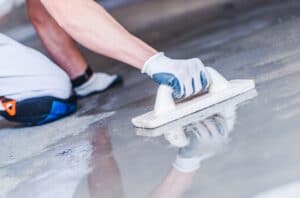The 10 Most Popular Tile Materials

When it comes to choosing tiles for your home, you’re pretty much spoiled for choice. Whether you’re looking for wall tiles or floor tiles, there are a staggering amount of options out there for you to choose from.
To make it a little easier for you, we’ve rounded up 10 of the most popular options out there. We’ll talk a little bit about how these tiles are made, what their strengths and weaknesses are, and when you should use them.
This certainly isn’t an exhaustive list, but it should help you get a better understanding of the most popular tile materials available on the market today.
1. Ceramic Tiles
Along with porcelain, ceramic is easily one of the most popular choices out there. These tiles are clay-based and fired in a kiln. These tiles are relatively soft and have a great feel underfoot. This softness also makes ceramic a great choice for DIY, as they’re super easy to cut and lay.
However, this softness also means they’re not particularly durable and may chip easily. They also won’t stand up well to water without a waterproof glaze added. Generally, this is a pretty versatile tile but we wouldn’t necessarily recommend it for showers or high-traffic flooring.
These days, most people go for Ceramic’s harder cousin, Porcelain, as it’s more durable for a similar price. But one thing that Ceramic has going for it is the wide range of colours. There are so many bright and colourful options to choose from that just aren’t available in Porcelain
2. Porcelain Tiles
Arguably the most popular tile on this list, ceramic is a great all-rounder. porcelain tiles are actually a sub-type of ceramic tile, but they’re generally the better choice. Porcelain has been fired in the kiln for longer than regular ceramic and at much higher temperatures.
This makes for a stronger and more waterproof tile that will do great anywhere in your home, especially in a bathroom. Porcelain has a reputation for being a bit harder to DIY than ceramic, but we think the difference is negligible. Check out our breakdown of Porcelain vs Ceramic Tiles to figure out which one you should use.
Because porcelain is so sturdy and affordable, it’s a great substitute for many of the more temperamental natural materials on this list. Stone-look porcelain tiles are a great solution when natural stone just isn’t a practical choice.
3. Cement Tiles
Cement tiles are pretty trendy at the moment, and it’s easy to see why. They’re a visually appealing tile that’s easy to customise. There are some really cool patterns and colours out there to choose from, and the naturally porous nature of concrete adds great natural texture.
One of the biggest draws of a cement tile is that it can be sanded and resealed like a wooden floor. The downside is that laying cement tiles is a serious task, even for an experienced DIYer. They also need consistent upkeep over time, so we’d recommend this for a small, visually exciting feature area and not anywhere with super high traffic.
4. Glass Tiles
Glass tiles are beautiful but fragile, as you might expect. They’re also very popular as a relatively affordable option. These glass tiles may chip easily, but they’re unbelievably easy to clean and care for. Most things will wipe right off and they don’t really stain.
These will best suit a minimalist aesthetic or a wall mosaic, and we don’t recommend using glass for floor tiles at all. However, because they’re so easy to clean, glass is one of the best options out there for kitchen splashbacks, feature walls or benchtops.
5. Granite Tiles
There are a lot of different stone tiles out there, but granite is probably the most popular. A hard and dense stone, granite is incredibly durable, which makes it a great choice for high-traffic areas. We recommend granite pretty much anywhere as a floor tile, as it’s going to last a long time. However, it may be too heavy to make for a practical wall tile.
Granite offers a hint of luxury without breaking the bank like Marble or Onyx might. As a natural material, the naturally occurring patterns in granite mean that no two tiles ever look exactly the same. One downside of granite is that it’s naturally hard and cold, which can feel a bit bracing underfoot, especially on a chilly winter morning.
6. Marble Tiles
One of the most iconic tiles out there, marble tiles are synonymous with luxury and refined beauty. The downside, obviously, is that marble is bloody expensive.
It’s also surprisingly hard to clean and it scratches and stains easily, meaning it’s not a good option for high traffic areas. We recommend using marble sparingly for effect if you don’t want your upkeep budget to give you a headache.
If you’re looking for a slightly cheaper alternative to marble, try quartzite or onyx tiles. These two stones are visually similar to marble, widely available, and perform in roughly the same way.
7. Limestone or Travertine Tiles
Limestone is another highly popular stone tile that has a great classic look. It’s naturally abundant in Australia, which makes it a relatively affordable option compared to other stone tiles. It’s also low maintenance – really, this tile has a lot going for it. It can be a pain to clean though, because it’s naturally very porous and stains easily.
Limestone naturally forms near underground water and so handles wet environments extremely well when properly sealed. It’s also highly slip-resistant, making it a great choice for bathrooms or outdoor pool areas. Overall, its soft and porous nature makes it easy to DIY, but this also means it can degrade quickly if it’s not sealed properly.
One of the most popular forms of Limestone for tiling is Travertine. This particular type of limestone material was extremely popular in Ancient Rome, and many travertine-tiled buildings are still there, so you know it’s going last a very, very long time! Travertine is the go-to material if you want an ‘antique’ look.
8. Quarry Tiles
Quarry tiles are also a very popular choice. These tiles are made from ground-up minerals like clay and shale and fired at extremely high temperatures. They’re actually pretty similar to bricks – both in their visual look and in the way they’re made – but they’re much more solid and durable.
These tiles are naturally slip-resistant and are a great choice for any high traffic area. Visually, they often look great as an outside tile as they’ll match a brick home. One place we wouldn’t recommend using these tiles is the kitchen, as they stain quite easily and the stains are hard to get out.
9. Mosaic Tiles
You’re probably familiar with mosaic tiles. They’ve been popular for thousands of years, and they’re still pretty trendy today. There are countless styles, colours and patterns to choose from, and mosaic tiles are great for visually exciting feature areas, splashbacks or even small bathrooms.
However, using too many of these tiny tiles will be a headache to install and likely a headache to look at, too. We love mosaic as much as the next bloke, but we recommend taking it easy with this one.
10. Terrazzo Tiles
These colourful tiles have been around since the 16th century, and they’re still pretty trendy these days. Terrazzo tiles take tiny chips of stone like marble, granite or quartz and set them inside a binding material, usually concrete.
These are hard, durable tiles and they’re visually very appealing, especially in sunlight. They’re inexpensive to make, so they’re a surprisingly affordable option. They’re also easy to care for. However, they’re not easy to install, and we wouldn’t try DIY-ing this one.
The downside of Terrazzo is that it’s got a reputation for being very slippery when wet. For this reason, we don’t recommend it for bathroom or kitchen floors. However, it’s still a great option for a visually-striking bathroom feature wall.
Hopefully, this guide has expanded your understanding of tiles a little bit. These 10 tile materials are probably the most popular tiles out there today, so knowing about them will help make choosing the right tile a lot easier.
At Multifors, we’ve focused on stocking a huge range of porcelain tiles and ceramic tiles. We think they’re an amazing substitute for many of these trickier natural materials, and we’ve got lots of looks in trendy styles like marble, terrazzo, cement and more.
-
 11, Jul, 2022
11, Jul, 2022Feature Product: The Stain Proof Range
We regularly review some of our favourite products. Today, we’re... -
 5, Jul, 2022
5, Jul, 2022Concrete Sealer: What You Need to Know
Concrete is a sturdy material that’s practical and affordable. In... -
 24, Jun, 2022
24, Jun, 2022A Product Guide for DIY Pool Areas
Tiling a pool area is a great DIY project. In...


